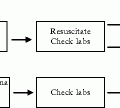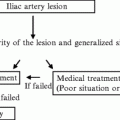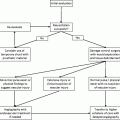Vessels
View
Internal iliac
Opposite oblique
Uterine artery
Opposite oblique
4.
A cobra, Rim or a reverse curve catheter such as a Roberts catheter is advanced over the bifurcation and into the contralateral internal iliac artery.
5.
From this position using the opposite oblique positioning, a digital roadmap should be performed to identify the uterine artery origin. If the origin is not well identified in the contralateral oblique position, it may be necessary to try a roadmap in the ipsilateral oblique position. Visualization of the uterine artery is critical for successful catheterization.
6.
Using a 0.027 microcatheter and microwire, the uterine artery is selected and catheterized. The uterine artery is tortuous and passage of the catheter may take several attempts. Unfortunately, the artery is prone to spasm and care must be taken in its selection. The artery has a “U-shaped” as it turns medially along its course toward the uterus. The microcatheter should be advanced beyond the cervicovaginal branches when possible to reduce the risk of nontarget embolization.
7.
Spasm of the vessel can be avoided with careful technique. Spasm may be flow limiting, which can lead to under embolization and a false endpoint. If spasm is encountered intra-arterial nitroglycerin or papavarine may be used. Often the only option is to retract the catheter and wait for the vessel spasm to resolve.
8.
If simultaneous bilateral embolization is going to be performed, the above steps are repeated to catheterize the opposite uterine artery. When both vessels are properly selected, angiography of the uterine arteries should be performed simultaneously to assess flow and fibroid distribution. Careful evaluation of the angiogram will help guide the selection of embolic material.
9.
If a unilateral approach is used, after successful catheterization of the uterine artery, followed by embolization, a Waltman loop is used to remove the 5 Fr catheter over the aortic bifurcation.
9 Embolic Choice and Technique
(a)
The goal of embolization for postpartum hemorrhage is rapid occlusion of the feeding arteries. Most often this can be accomplished with a gelatin sponge slurry which has advantages in that it is quick and considered a temporary agent. Coil embolization is generally not performed because it only provides proximal vessel occlusion. The tendency for collateral vessels in a gravid uterus will make such proximal occlusion inadequate. Particulate embolic material and microspheres should be avoided as it may lead to myometrial injury.
(b)
Embolic materials used for preoperative and fibroid embolization should be permanent and be small enough to be carried to the distal circulation. Two well-studied materials are particle PVA (Contour, Boston Scientific; Natick, MA; Ivalon, Cook Inc. Bloomington, IN; others) and Embosphere® Microspheres, Biosphere Medical, Rockland, MA). Spherical PVA (Contour SE, Boston Scientific; Natick, MA) has been shown to be inferior in fibroid infarction and should not be used for UFE. Two newer products, acrylamido PVA hydrogel spheres (Bead Block™, Terumo, Somerset, NJ) and Polyzene F®-coated hydrogel spheres (Embozene™Microspheres, Celanova Biosciences Inc., Newnan, GA), have not been studied in comparative trials.
(c)
In UFE, embolic material is administered in small aliquots using the flow in the uterine vessels to carry the embolic material distally. The goal is not to occlude the entire uterine artery, but to leave it with slow flow or near stasis. Supplemental embolization with coils should not be performed, as this will completely occlude the uterine arteries preventing future embolization if the patient develops new fibroids. Occlusion also causes unnecessary ischemia of the normal myometrium, causing unnecessary pain and increases the risk of tissue injury.
10 Ovarian and Collateral Supply
(a)
There is occasionally additional supply to the uterus and fibroids from the ovarian arteries. Although only present in about 5% of patients, this supply can impact outcome. Routine aortography after embolization is low yield but may be performed when there is clearly nonperfused tissue seen on uterine arteriography. An aortogram should be done to determine collateral supply in cases of postpartum hemorrhage and preoperative embolization.








